| Home | Current show | Photography/Calligraphy | Show archives | Japanese pottery | Tea bowls | Sumi-e | Gallery tour | Wabi sabi |

Touching Stone Gallery Santa Fe New Mexico USA
www.touchingstone.com Email: director@touchingstone.com

Touching Stone Gallery Santa Fe New Mexico USA
www.touchingstone.com Email: director@touchingstone.com
|
Hiroyuki Wakimoto Omen America Debut Exhibition, July 2002 |
||
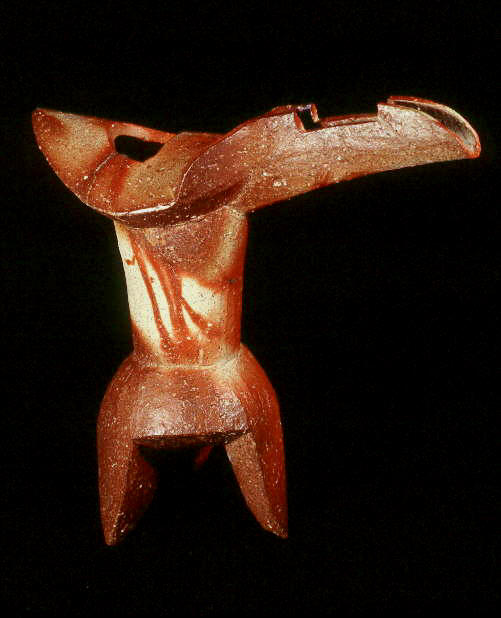 See more of this artist's work: 2002 show, 2003 show, 2004 show, 2005 show, 2006 show, 2007 show, 2009 show, 2010 show, 2012 show, 2016 show |
||
|
Inquiry/order:
director@touchingstone.com |
||
|
"Myth #1" Ceramic vase/flask 9.25 x 9.25 x 4 inch Sold
|
"Myth #2" Ceramic vase/flask 9.5 x 9.5 x 4 inch Sold
|
"Myth #3" Ceramic vase/flask 7 x.6.5 x 3.5" Sold
|
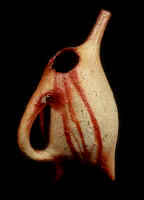 |
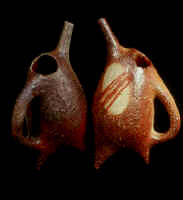 |
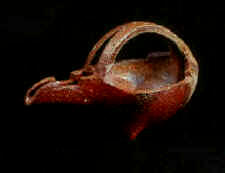 |
|
"Figment #1" Ceramic pitcher 9 x 5.5 x 4.5 inch Sold |
"Figment #2" Ceramic pitchers 9 x 5.5 x 4 inch Sold |
"Fable" Ceramic pitcher 5.5 x 9 x 5 inch Sold |
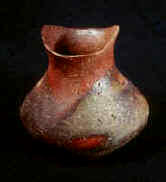 |
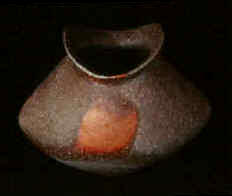 |
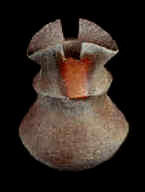 |
|
"Quietude" Ceramic vase 6.5 x 7 x 5 inch Sold |
"Resolute" Ceramic vase 7.5 x 10.5 x 7.5 inch Sold |
"Passage" Ceramic vase 8 x 6 x 5.5 inch Sold |
|
"Arches" Ceramic vase 9 x 9.5 x 7.5 inch Sold |
"Trinity" Ceramic vase 9 x 4.5 x 4.5 inch Sold |
"Willow Moon" Ceramic vase 11 x 11 x 7.5 inch Sold |
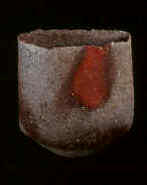 |
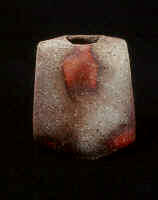 |
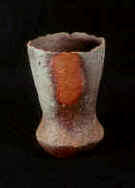 |
|
"Scarlet Transformation #1" Ceramic vase 7.75 x 7 x 3.5 inch Sold |
"Scarlet Transformation #2" Ceramic vase 8.5 x 7 x 3 inch Sold |
"Scarlet Transformation #3" Ceramic vase 6.75 x 4 x 4 inch Sold |
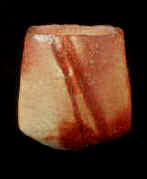 |
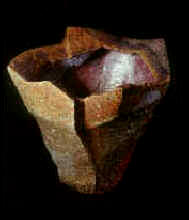 |
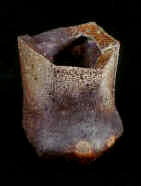 |
|
"Scarlet Transformation #4" Ceramic vase 7.75 x 7 x 3.5 inch Sold |
"Metamorphosis" Ceramic vase 10.5 x 11.5 x 10.5 inch Sold |
"Mystic" Ceramic vase 8 x 6.5 x 6 inch Sold |
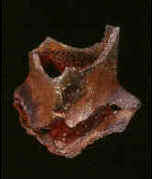 |
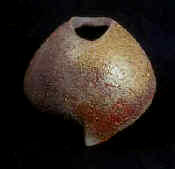 |
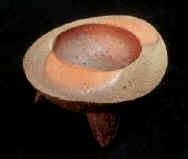 |
|
"Riddle" Ceramic vase 7 x 8.5 x 5.5 inch Sold |
"Serenity" Ceramic vase 7.5 x 8 x 4.5 inch Sold |
"Moon Pool" Ceramic bowl 4 x 7.5 x 6.5 inch. Sold |
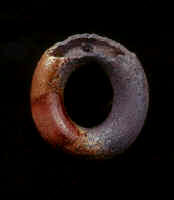 |
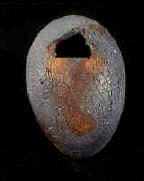 |
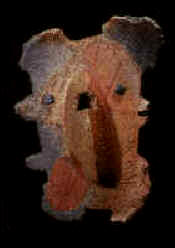 |
|
"Vice & Virtue" Hanging vase 6.5 x 5.5 x 1.5 inch Sold |
"Balancing Void" Hanging vase 8 x 4.5 x 4 inch Sold |
"Yoda" Wall sculpture/hanging vase 18 x 12 x 5 inch Sold |
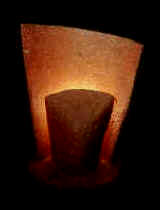 |
||
|
"Solitude" Ceramic light sculpture 12 x 10 x 8 inch Sold |
||
|
Omen - Hiroyuki Wakimoto's contemporary Bizen
ceramic* They called it Feng-Huang, a mythical three-legged bird that would appear once every few hundred years. According to old Chinese legends, the bird’s appearance was a good omen. Throughout Chinese history, this mythical creature has been depicted in various art forms. Among ancient Chinese pottery from the Neolithic era (12,000 – 2,000 B.C.), odd-looking vessels called gui with tripod legs and pointed spouts might well represent objectification of the creature. It was one of these ancient vessels seen in a museum that inspired Japanese ceramist Hiroyuki Wakimoto to create some of his most original forms to be shown in a one-person exhibition at the Touching Stone gallery in Santa Fe, New Mexico. A centerpiece of the exhibition is an unusual creation entitled "Myth". It has the head of a prehistoric Pterodactyl, with strong jawbones and an enormous overhanging beak. A muscular faceted neck craned to the side supports the head, and its small body rests on three short pointed legs. It is plumed with beautiful reddish ash glaze and distinctive fire-mark decorations. The top of the head bears a semicircular opening, and the beak is grooved for pouring. Odd as it seems, "Myth" is functional either as a sake bottle or flower vase. It is a very bold expression of artistic creativity. Unlike many other Japanese ceramists, Hiroyuki Wakimoto was not born into a family of potters. He was originally from Tsushima, Nagasaki Prefecture in Kyushu. He first studied textile design in a prestigious art school, Osaka Art College. Not until he was in his senior year did he realize that textiles were really not his interest. He left college and went back to his hometown to help in his parents’ business. A visit to a college friend who was doing an apprenticeship with a ceramist in Bizen proved to be a turning point in his life. He was inspired by Bizen-yaki and, at the age of 30, he became an apprentice under accomplished ceramist Joji Yamashita. Nine years later, in 1990, Wakimoto established his own kiln and studio in Bizen. As one of the six oldest pottery centers in Japan, Bizen has produced many exceptional ceramists, including a number of National Living Treasures. There is an enormous legacy for any Bizen ceramist to live up to. Realizing that he must make up for his relatively late start in ceramics, Wakimoto concentrates on developing a personal style. His fascination with form compels him to create some of the most interesting works in contemporary Japanese ceramics. His pieces are instantly recognizable by the bold, meticulously conceived forms with clean strong lines and his signature fire markings. Two other recent pieces entitled "Figments" show Wakimoto’s unique style. These comical three-legged pitchers look like penguins involved in a mating dance, with bellies budging and beaks pointing skyward. One is finished in brilliant Bizen red ash glaze with intense hidasuki (fire-cord) decorations, the other in a more subdued but equally attractive color. Producing such a wide range of forms and effects requires foresight and experimentation. As an essential step in his creative process, Wakimoto keeps a notebook of new ideas that come to mind. He also takes great care to document his firing procedures, keeping detailed data on temperature and positions of the pieces in his nobori-gama (climbing kiln). This methodical approach frees the artist from haphazard guesswork, allowing him to focus on turning his abstract visions into tangible forms. Guided by his accumulating experience, Wakimoto has developed a sense of balance in blending his creative energy with enough control so that his work is neither boring nor contrived. Take for example his flower vase entitled "Resolute". Its elegant shape perfectly complements the subtle coloration set off by a bright botamochi (round rice ball) fire-mark. It is at once aesthetically quiet and visually stunning. Another example that displays Wakimoto’s aesthetic sensibility in combining form and color is an oblong flower vase entitled "Arches". The most prominent feature of this piece is a pair of parallel arches formed by carving slanted notches into the top edge of the vase. Even with such manipulation, the piece nonetheless looks complete. Brilliant crimson hidasuki lines flow delicately down the face of the vase, adding visual and textural contrast against the rough clay body. More recently, Wakimoto has been interested in sculpting free forms, and in the interplay of light on clay surface. He recalled this development: "In the beginning, I cared too much about making my work unique, and my hands struggled with the clay. Then one day, I told myself to just set my hands free to express my honest feelings without thinking too much about it. From that day, I felt so relaxed and my work became more spontaneous". One of his latest works, "Yoda", is a bold and impressive sculpture. Yoda’s body is a functional flower vase with a mouth that seems to be sighing. Its black eyes are the protruding heads of iron bolts that also serve as anchors for a steel cable in the back for hanging the piece on a wall. Another recent piece, "Metamorphosis", is a large hand-formed vase with a myriad of intersecting angles and surfaces. Under diffused lighting, the piece appears unremarkable. However, when illuminated directionally from different angles, the piece takes on chameleonic characteristics that invite close examination. Wakimoto’s exploration into the interplay between light and surface led to a series of light sculptures. "Solitude" is a striking example of this direction. The simplicity of this piece belies the artistic vision behind the design: a small lamp hidden behind a wedge-shaped boulder illuminates a gently curving clay surface. By means of an integral dimmer switch, the viewer controls the light intensity, thereby changing the perception of the sculpture. In a darkened room, the sculpted forms and textured surfaces gently reveal themselves with mesmerizing effects. Wakimoto’s innovative work has been enthusiastically received in shows throughout Japan. Despite his popularity, Wakimoto keeps his sense of humility. In a recent interview, the artist mused, "As an outsider who arrived at Bizen almost by chance, I was taught everything about Bizen-yaki that had taken hundreds of years to develop. I hope someday I can contribute my share of knowledge to the continuous evolution of Bizen-yaki as a way of repaying the generosity of my adopted home town". For now, the impact of Wakimoto’s work, like a premonition brought forth by the mythical bird that once inspired him, may foretell an era of new spirit and creative energy in this ancient center of Japanese ceramic. *From an article
entitled Omen by Tim
Wong and Akiko Hirano in Ceramics: Art & Perception, Vol.48, 2002. |
||